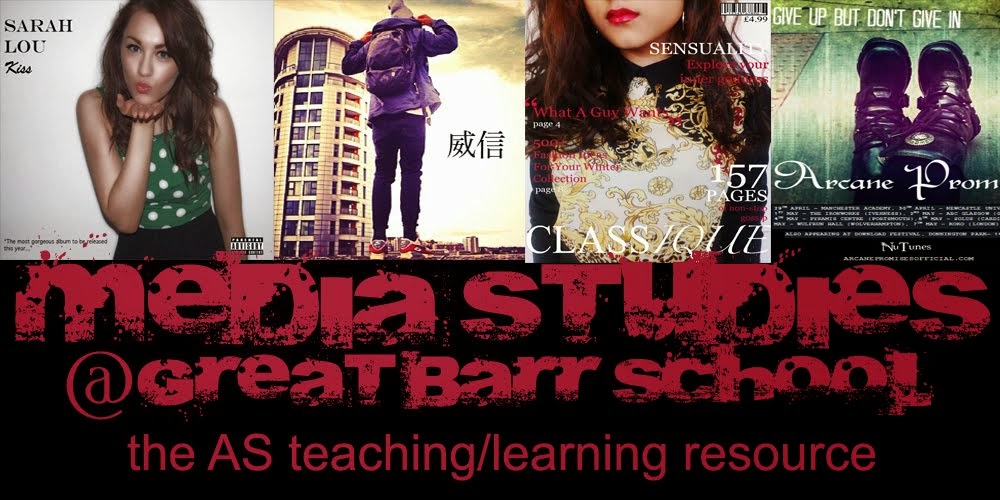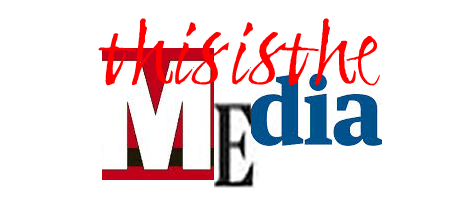media studies

student work 2012/14
Thursday 30 April 2015
BORROWED IDENTITIES - BUT WHOSE?
The front pages of today's [ 30th April 2015] Sun and Scottish Sun make an interesting study in media identities, media institutions and audience.
Ideology and institutions - both newspapers today announced their support for a particular political party in the national Westminster elections due on the 7th May. It is of no real surprise that the Sun [circulation England] announced backing for the Conservative Party [aka the Tory party] whilst the The Scottish Sun [circulation Scotland] declared for the SNP [Scottish Nationalist Party whose aim is an independent Scotish Parliamnet ruling an independent Scotland]. What might be of some surprise is that the Sun announces one of the three key reasons for supporting the Tories being to 'stop the SNP running the country' - the idea that a minority Labour Party might seek to form a government by making a deal with the SNP to form a coalition government and, in doing so, be at the mercy of Scottish demands harmful to English voters. At the same time its 'sister' paper in Scotland was urging its readers to vote SNP.
Borrowed interest / inter-textuality - the design of the front pages are both examples of the application of borrowed interest. The referencing by one product of another in order to create some deeper understandings with audiences.
The Sun takes the idea of new baby cards - it's a boy! / it's a girl! - references and the image of the swaddled new-born baby with Cameron's head on it. They also borrow interest from the story around the anticipated birth of the second royal baby for Kate and William.
The Scottish Sun opts for Star Wars in its depiction of Nicola Sturgeon [the SNP leader]. the caption of STUR WARS is a play on the title of the mega successful film franchise as well as utilising the iconic font. The tag line of 'May the 7th be With you' also borrows heavily from the tag of the film - may the force be with you. Sturgeon is dressed as Princess Leia wielding a light-sabre.
We might also consider why these images are used - apart from being eye-catching. The royal birth might be selected because it is contemporary, the star wars reference, however, is not. However, both have deeper implicit meanings for their intended audience. The Sun is about birth, new starts, beginnings and hope. The Scottish Sun is about heroes [pure and dressed in white], noble champions who fight against oppressive forces of Empire. Such implicit messages resonate at a very deep psychological level with their intended audiences and demonstrate Hall's encoding/decoding model in action in terms of the intention of the institution.
Talking of institutions - how can a newspaper represent two differing ideologies for its audiences? Both are part of the News International Group and thus are owned by Rupert Murdoch but both claim to have separate identities and independence of editorial decision making.
http://www.theguardian.com/politics/2015/apr/29/the-sun-backs-the-tories-for-election-but-scottish-edition-backs-the-snp
Wednesday 29 April 2015
the black orchid : Revision issues for Section A
Worth a moment to think about some wider contexts and the examination. Here is a judgement from ASA about the latest [last] controversial ad campaign.
It is worth considering the issues around why the ASA made this judgement.
[1] The nature of the audience seems to be the mitigating factor in the defence case as well as it being the initiating issue for the complaint - the relative proximity of a school and a mosque. The complainants made such close proximity a reason for their objection to its presence; the defence convinced the ASA that the relative distances fell outside the guidelines of 100 metres.
[2] It offers some insight into matters such as footfall [almost 23,000 people a day] that the ad company would use to market this site to potential advertisers as well as the profile of that footfall [young; aspirational].
[3] Clearly, it was the decisive factor in the judgement as much as was the debate over the line between 'sensual' and 'sexual' - the latter a good example of a matter of Hall's encoding/decoding model of interpretation and audience perceptions.
Tuesday 28 April 2015
ARE YOU EXAM MIND READY?
The controversy that has arisen ever since the above advert for protein world appeared is a good example of how the media operates, the impact of media products, zeitgeist, media theory and good old fashioned popular culture.
The story so far... Protein World put together a PR promotion for their range of products [a series of slimming aid supplements branded: The Weight Loss Collection] which had, as a key element, a London tube poster campaign. The campaign asking the audience 'are you beach body ready' was accompanied by an image of Australian model Renee Sommerfield in a bikini. The colour palette was a vibrant and striking yellow and black, ensuring it stood out in the selected environment.
Almost immediately it provoked a hostile reaction on social media with many criticising the choice of model and caption as promoting a regressive body image that implied that the body image depicted [slim; toned; sexualised] was deemed to be the only one desirable to have and implying that any one not this shape should feel less attractive [or worthy?],that is to say, not ready for showing on the beach.
The image appeared on social media feeds - particularly Twitter - where the advert had often been defaced or had additional slogans added to it ridiculing the campaign and its attitude towards women. A number of women also posed in tube stations standing in front of the poster dressed only in their underwear or bikinis to draw attention to the image's negative impact on anyone less than the perfect body of the model.
'The entire premise of this campaign is utterly ridiculous. I am tired of seeing one body type pushed across advertising campaigns, television and everywhere else'
There it might have remained until Katie Hopkins decided to get involved in the controversy. Hopkins, a well known and polarising columnist for the Sun, posted a series of tweets hostile to the critics of the advert:
Chubsters, quit vandalising @proteinworld ads & get your arse running on the road. Feminism isn't an excuse for being FAT. #EatLessMoveMore
http://www.huffingtonpost.co.uk/2015/04/27/katie-hopkins-stirs-protein-world-ad-controversy-inviting-angry-chubsters-catch-her_n_7152036.html?utm_hp_ref=uk
The series of tweets that were highly inflammatory to people who were overweight pushed the debate deeper into the public awareness. In the tweets she was able to be even more direct in the invective she poured out than in her column. No doubt such debates boost her own profile.
An online petition attracted 50,000 signatures in a protest aimed at changing the advert. The company remained fixed in its position, refusing to alter the adverts as they claim this would amount to their agreeing with the protesters that the adverts were body shaming. The chief executive of the company saw the backlash grow exponentially when he appeared on Channel 4 and claimed those complaining about the poster and defacing adverts were “terrorists” and “extremists” who “shout a lot”.
The matter has also seen an increase in sales of 40% to its 300,000 customers and an increase in 5,000 new subscribers for their online sales in the first four days of the controversy [late April 2015]
Application of media:
So what media theory and debates can we apply here?[1] Well there's always the good old controversy creates attention and profit for the company issue we've explored with so many previous brand campaigns. Clearly many more people [possibly millions more] have seen the London Tube advert than would otherwise have been aware of their existence. The controversy - fuelled by the Protein World response - has lead to TV news coverage, appearances on TV discussion shows as well as features in most newspapers and countless online social media blogs let alone the hundreds of thousands of ordinary daily Tweets and Facebook activity that all develop public awareness of the brand - is there such a thing as bad publicity? The huge 50,000+ petition lead to a public protest meeting in Hyde Park [with all that media coverage]. It has also lead to a massive increase in sales for the Protein World products.
[2] The power of social media - the spread of the issue, the sharing of the image, the petition, the PR battle, the mash-ups of the image that are then tweeted, the graffiti images photographed and then shared, the notoriety of Katie Hopkins - tells us much about the zeitgeist but also the impact of the technology that enables such events to travel and to gain traction in the public consciousness.
[3] The impact of regressive tropes and public awareness and hostility to these - we might look at Blumler here and the needs of identity. Perhaps even McComb and agenda setting might be useful as a means of exploring this.
[4] Popular culture debate - the saturation of such images on our media output. The model is a celebrity vegan and has herself joined in the debate, defending the shoot and the use of the image as being simply 'one' body [hers] and not a message aimed at saying it should be the shape of 'all' bodies. Whatever the constructed intention, the Encoding/Decoding theory [Hall] shows in the differing understanding of the advert's intention by the audience according to their own ideologies and beliefs. The fact that any use of a 'slim' model may well be interpreted negatively is clear. The fact that a celebrity columnist will use such reactions to create a different debate is the novelty. The feminist/body image issues have become blurred in a manner that detracts from fully engaging with either but is an area a media student must have an understanding of why this is so.
Subscribe to:
Posts (Atom)





